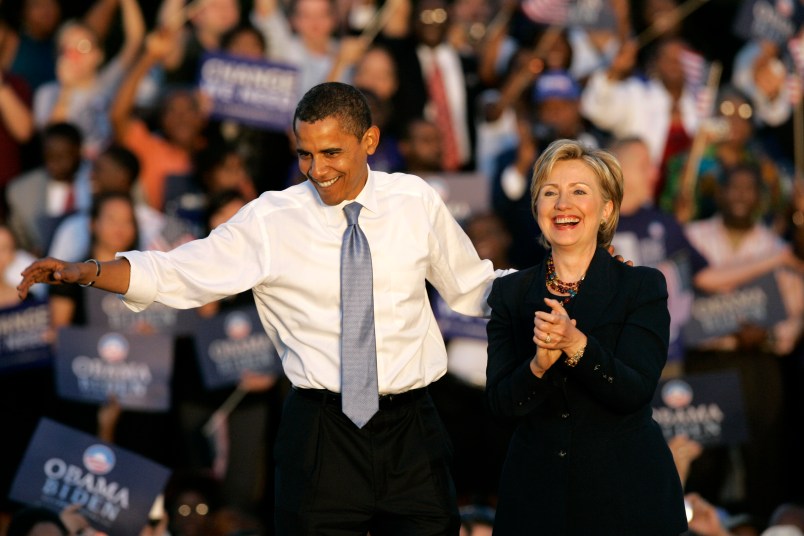The top minds in the proto-Hillary Clinton 2016 campaign infrastructure are already gaming out Electoral College scenarios. What they think they have is a candidate who could compete in a handful of traditionally red states, putting Republicans on the defensive and increasing her chances of winning the White House.
Mitch Stewart, Obama’s 2012 battleground state director who is now an independent consultant advising the grassroots group Ready for Hillary, laid out the electoral math to TPM in a recent interview. Clinton will start with Obama’s map, he said, and can build from there.
There are two buckets of states potentially in play. Arkansas, Indiana and Missouri comprise one bucket. The first is a somewhat unique case, given Clinton’s history there, while the other two were razor-thin in 2008, but the principle is the same: Clinton has a record of appealing to white working-class voters — especially women — and they could be enough when paired with the Obama coalition to pull out a win.
“Where I think Secretary Clinton has more appeal than any other Democrat looking at running is that with white working-class voters, she does have a connection,” Stewart said. “I think she’s best positioned to open those states.”

Stewart pointed to Clinton’s sizable 2008 primary wins in Pennsylvania and Ohio, along with the enthusiastic support for her from former Indiana governor and senator Evan Byah, as evidence of her potential competitiveness with that population and therefore in those states.
Those white working-class voters in those states could be “the difference between winning and losing, assuming that we maximize turnout, we maximize voter registration in St. Louis, Indianapolis and northwest Indiana,” he said. “Assuming we do all those things, the fact that would push her over the top is her appeal to white working-class voters.”
The second bucket consists of Arizona and Georgia, two states that Democrats believe are demographically trending toward them, a process that could accelerate with the voter turnout that usually occurs in presidential elections. As Stewart put it, they are “structurally on the precipice of becoming purple states and a presidential campaign can be the catalyzing factor to move those states forward.”
Georgia combines an increasing African-American electorate, Clinton’s appeal to the white working class and northern voters who are moving into the state. Stewart compared the trend to North Carolina, now an established battleground. Arizona can turn blue, Democrats believe, if they mobilize the growing Hispanic population.
None of these states are likely to be the key 270th electoral vote, Stewart emphasized. The electoral tipping point is still likely to be the traditional battleground states: Iowa, New Hampshire, Virginia, Ohio, Colorado and Nevada. But if Democrats can make these other states competitive, it gives them more room for error and forces Republicans to expend resources in places that have traditionally been marked down as wins for them before the campaign even starts.
“If Republicans have to spend resources in Arizona and George to make sure that they win it, that means that they’re spending less resources elsewhere,” Stewart said. “The further we can play into their field, the more money they’re going to have to spend playing defense in places they’ve normally taken for granted.”
Stewart’s outlook is a common one in the Hillary 2016 universe. The New York Times’ Amy Chozick reported earlier this month that Clinton supporters have a term for it — the “New Clinton Map,” which combines white working-class women with the Obama coalition to expand the electoral playing field.
Other top Democratic strategists, not as immediately involved in Clintonland, agree that they might be onto something.
“I think Hillary Clinton can be a temporary salve to Democrats’ fading chances with white voters, primarily because she will attract women,” Carter Eskew, a top adviser to Al Gore’s 2000 campaign, told TPM. “If she supplements her gender appeal with a real contrast on the economy, then all the better.”
That will be key, Stewart agreed. Clinton has already been testing a 2016 message that heavily emphasizes wage growth and expanding the middle class. That’s how she’ll attract those voters that could bring these additional states into reach.
“For whatever reason, Democrats have not been able to articulate a message that resonates even though our economic values align with that working-class family’s economic values,” Stewart said. “It’s something that we have to figure out.”
It is not a universally shared opinion, however. Mother Jones’s Kevin Drum outlined why Democratic struggles with the white working class have become so ingrained in recent years. Larry Sabato, director of the University of Virginia’s Center for Politics, sounded skeptical when asked by TPM about Clinton’s ability to break through with that population.
“It’s possible, but I’ll believe it when I see it,” he said in an email. “The hardening of party lines during the Bush and Obama years make switches more difficult unless they are propelled purely by demographic shifts.”
Others within the Democratic Party cautioned, though, that no matter who the 2016 nominee is, working-class whites shouldn’t be viewed as an electoral elixir. The base Obama coalition is still the foundation for national wins.
“As you put together the coalition, it still is an important part. What’s important is that a Democrat gets a certain respectable showing there,” Kenneth Baer, a former Obama administration official and founder of Democracy: A Journal Of Ideas, told TPM. “It is necessary to win a part of the white working-class vote, but it is not sufficient by any means to win a presidential election as a Democrat. And so you really, really need to perform strongly in those other categories as well.”









